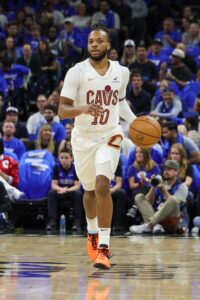The bi-annual exception is one of the tools available to NBA teams who are over the cap, giving those clubs the flexibility to offer free agents more than the minimum salary. In 2024/25, the bi-annual exception is worth $4,668,000 and can be used to offer a deal worth up to $9,569,400 over two years.
However, the bi-annual exception isn’t available to every team. Clubs that go below the cap in order to use cap room lose access to the exception. Additionally, using the BAE imposes a hard cap of $178,132,000 (the first tax apron) on a team. So if a club has surpassed the first apron – or wants to retain the flexibility to do so – it can’t use the bi-annual exception.
Finally, as its name suggests, the bi-annual exception can’t be used by a team in consecutive years. In 2023/24, three teams used the BAE — the Lakers (Taurean Prince), Cavaliers (Ty Jerome), and Raptors (Jalen McDaniels). As such, the exception isn’t available to those clubs during the 2024/25 league year. They’ll be able to use it again next summer.
With all those factors in mind, here’s a breakdown of how teams are using – or not using – their respective bi-annual exceptions in 2024/25:
Available Bi-Annual Exceptions:
Unused:
- Atlanta Hawks
- Brooklyn Nets
- Chicago Bulls
- Dallas Mavericks
- Golden State Warriors
- Indiana Pacers
- Memphis Grizzlies
- New Orleans Pelicans
- Portland Trail Blazers
- Sacramento Kings
- Washington Wizards
Although all of these teams technically have the ability to use their bi-annual exceptions at some point in 2024/25, it’s more plausible for some than others.
For instance, the Warriors currently have less than $1MM in breathing room below the first apron, so using even a small portion of their bi-annual exception won’t be an option until much later in the season unless they make a cost-cutting move.
Conversely, the Grizzlies have more than enough wiggle room below the first apron to use their full bi-annual exception, but they also still have their full $12.8MM mid-level exception available — if they need to offer more than the veteran’s minimum to sign a player, it will likely come out of their MLE, preserving their BAE for next season.
Used:
- Houston Rockets
- Used: $4,668,000 (Aaron Holiday)
- Available: $0
- Los Angeles Clippers
- Used: $4,668,000 (Nicolas Batum)
- Available: $0
Typically, about two to four teams in a given league year use the bi-annual exception, and this season has yet to buck that trend.
The Rockets and Clippers are the only two teams to use any portion of their bi-annual exceptions to date, so they won’t have it available in 2025/26.
Unavailable Bi-Annual Exceptions:
Went under cap:
- Charlotte Hornets
- Detroit Pistons
- Oklahoma City Thunder
- Orlando Magic
- Philadelphia 76ers
- San Antonio Spurs
- Utah Jazz
These seven teams forfeited their right to the bi-annual exception when they went under the cap and used space this offseason.
Over first apron:
- Boston Celtics
- Denver Nuggets
- Miami Heat
- Milwaukee Bucks
- Minnesota Timberwolves
- New York Knicks
- Phoenix Suns
In theory, cost-cutting moves by these teams could put them in position to use their bi-annual exceptions. In actuality though, that’s a long shot, especially for clubs like the Celtics and Suns, whose team salaries are well beyond the second tax apron.
Used last year:
- Cleveland Cavaliers
- Los Angeles Lakers
- Toronto Raptors
As noted in the intro, these are the two teams that used their bi-annual exceptions in 2023/24 and, as a result, won’t have them again until 2025/26.

 “I don’t want to be traded,” Garland said. “Those are just rumors.”
“I don’t want to be traded,” Garland said. “Those are just rumors.”